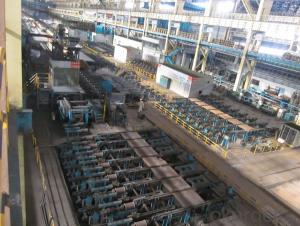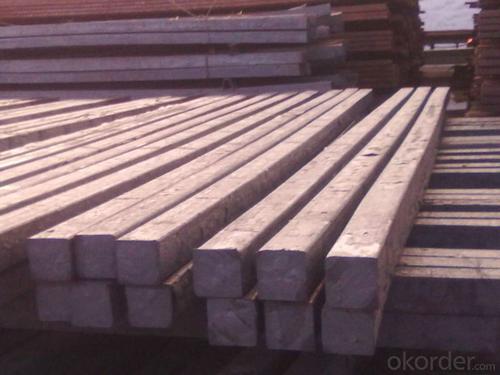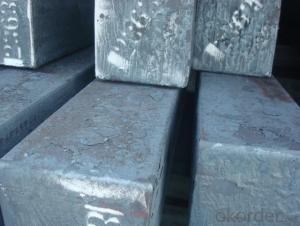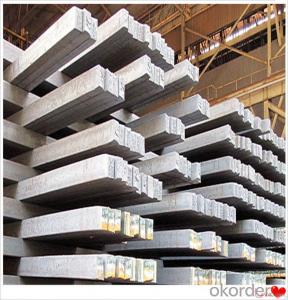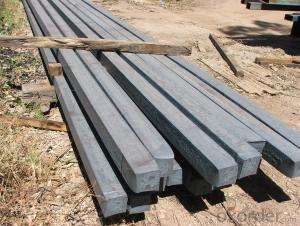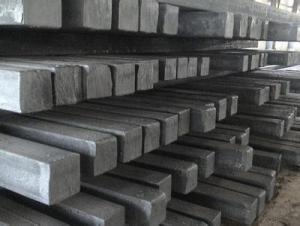Hot Rolled Square Steel Billet 3SP Standard 85mm
- Loading Port:
- Shanghai
- Payment Terms:
- TT OR LC
- Min Order Qty:
- 2000 m.t.
- Supply Capability:
- 10000 m.t./month
OKorder Service Pledge
OKorder Financial Service
You Might Also Like
Structure of Hot Rolled Square Steel Billet 3SP Standard 85mm

Description of Hot Rolled Square Steel Billet 3SP Standard 85mm
PPGI is made by cold rolled steel sheet and galvanized steel sheets as baseplate, through the surface pretreatment (degreasing, cleaning, chemical conversion processing), coated by the method of continuous coatings (roller coating method),
and after roasting and cooling. Zinc coating: Z60, Z80, Z100, Z120, Z180, Z275, G30, G60, G90
Alu-zinc coating: AZ60, AZ80, AZ100, AZ120, AZ180, G30, G60, G90

Main Feature of Hot Rolled Square Steel Billet 3SP Standard 85mm
1) Excellent corrosion resistance: The zinc layer provides a good protection of Pre-painted Galvanizeed Steel Sheet.
2) High heat resistance: The reflective surface of the material aids in efficiently reflecting the sunlight away and in turn reducing the amount of heat transmitted. The thermal reflectivity converts into energy savings.
3) Aesthetics: Pre-Painted Galvanized steel sheet is available in plethora of patterns and multiple sizes as per the requirements that given by our customers.
4) Versatility: can be used in the various areas.Standard seaworthy export packing: 3 layers of packing, inside is kraft paper, water plastic film is in the middle and outside GI steel sheet to be covered by steel strips with lock, with inner coil sleeve.
Applications of Hot Rolled Square Steel Billet 3SP Standard 85mm
1) Automotive bodies: filters, fuel tanks, etc.
2) Construction materials: roofings, welding pipes,
3) Electric and electronic appliances: computer cans, etc.
4) Steel cans: containers, etc.
5) Steel furniture: washing machines, refrigerators, microwaves, etc.
6) Drums
7) Office equipment: printer, recorders, etc.
8) Motors and transformers

Specifications of Hot Rolled Square Steel Billet 3SP Standard 85mm
| Classified symbol | Yield Point Minimum N/mm2 | Tensile Strength Minimum | Elongation Minimum % | Application | ||||
| N/mm2 | Nominal Thickness mm (t) | |||||||
| JIS | Yogic | 0.25-0.4 | 0.4-0.6 | 0.6-1.0 | 1.0-1.6 | |||
| G3312 | specification | |||||||
| CGCC | CGCC | -205 | -270 | -20 | -21 | -24 | -24 | Commercial |
| CGCD | CGCD | --- | 270 | --- | 27 | 31 | 32 | Drawing |
| --- | CG340 | 245 | 340 | 20 | 20 | 20 | 20 | Structural |
| CGC400 | CG400 | 295 | 400 | 16 | 17 | 18 | 18 | Structural |
| CGC440 | CG440 | 335 | 440 | 14 | 15 | 16 | 18 | Structural |
| CGC490 | CG490 | 365 | 490 | 12 | 13 | 14 | 16 | Structural |
| CGC570 | CG570 | 560 | 570 | --- | --- | --- | --- | Structural |
| ASTM Designation | Yield Point Minimum | Tensile Strength Minimum | Elongation Minimum % | Application | Q/BQB 445-2004(China standard) | ASM A653/A653M | JISG 3312 | |
| ksi(MPa) | ksi(MPa) | TDC51D+Z | (CS TYPE A+Z) | CGCC | ||||
| A653(M)-99 CS TYPE A,B,C | --- | --- | --- | Commercial | TDC52D+Z | CGCD | ||
| A653(M)-99 FS | --- | --- | --- | Lock Forming | TS250GD+Z | (G250+Z) | - | |
| A653(M)-99 DS | --- | --- | --- | Drawing | TS300GS+Z | (G300+Z) | CGC 400 | |
| A653(M)-99 SS Grade33(230) | 33(230) | 45(310) | 20 | Structural | TS350GD+Z | (G350+Z) | CGC490 | |
| A653(M)-99 SS Grade37(255) | 37(255) | 52(360) | 18 | Structural | TS550GD+Z | (G550+Z) | CGC570 | |
| A653(M)-99 SS Grade40(275) | 40(275) | 55(380) | 16 | Structural | ||||
| A653(M)-99 SS Grade50(345) | 50(345) | 65(450) | 12 | Structural | ||||
| A653(M)-99 SS Grade80(550) | 80(550) | 82(570) | --- | Structural | ||||
FAQ of Hot Rolled Square Steel Billet 3SP Standard 85mm
We have organized several common questions for our clients,may help you sincerely:
1. How Can I Visit There?
Our company is located in Tianjin City, China, near Beijing. You can fly to Tianjin Airport Directly. All our clients, from home or aboard, are warmly welcome to visit us!
2. How Can I Get Some Sample?
We are honored to offer you sample.
3. Why choose CNBM?
1, ISO, BV, CE, SGS approved.
2, Competitive price and quality.
3, Efficient service team online for 24 hours.
4, Smooth production ability(50000tons/month) .
5, quick delivery and standard exporting package.
6, Flexible payment with T/T, L/C, Paypal, Kunlun bank, etc .
- Q: How are steel billets manipulated during the manufacturing process?
- Steel billets are manipulated during the manufacturing process through various methods such as heating, rolling, forging, and cutting. Heating the billets makes them more malleable and easier to shape. Rolling involves passing the heated billets through a series of rollers to reduce their thickness and create desired shapes. Forging is another technique where the billets are shaped using compressive forces. Finally, cutting is done to obtain specific lengths or shapes required for further processing or fabrication.
- Q: If the casting speed is not steady, what will happen to the billet?
- The instability of the casting speed leads to the unstable surface of the mould and increases the probability of slag entrapment in the mold.
- Q: Can steel billets be customized in terms of shape and size?
- Yes, steel billets can be customized in terms of shape and size. They can be fabricated into various shapes and sizes to meet specific requirements and applications.
- Q: What are the main challenges in steel billet production?
- Some of the main challenges in steel billet production include maintaining consistent quality, optimizing production processes to minimize energy consumption and waste, ensuring proper inventory management to meet customer demand, and dealing with fluctuations in raw material prices. Additionally, meeting environmental regulations and addressing safety concerns are also significant challenges in steel billet production.
- Q: How are steel billets used in the production of automotive braking systems?
- Steel billets are an important component in the production of automotive braking systems. These billets are essentially semi-finished steel products that are used as raw material for further processing. They are typically manufactured through the process of casting, where molten steel is poured into molds and allowed to solidify. In the context of automotive braking systems, steel billets are primarily used to manufacture brake rotors or discs. These components play a crucial role in the braking system as they provide the surface on which the brake pads make contact and create friction, ultimately stopping the vehicle. Brake rotors are subjected to high levels of stress and heat during braking, and therefore require a material that is strong, durable, and heat-resistant, which is where steel comes into play. Once the steel billets are obtained, they undergo a series of manufacturing processes to transform them into brake rotors. The first step involves heating the billets to a specific temperature, which helps to enhance their malleability and make them easier to shape. This is followed by a process called forging, where the heated billets are subjected to high pressure to shape them into the desired form of the brake rotor. This forging process helps to improve the strength and integrity of the steel, making it more resistant to wear and deformation. After forging, the brake rotor undergoes additional machining processes. This includes turning the surface of the rotor to ensure it is flat and smooth, thus providing an even contact surface for the brake pads. The rotor may also be drilled or slotted to improve heat dissipation and prevent the buildup of gases or debris between the pad and rotor. These machining processes help to achieve the required dimensions and surface finish of the brake rotor. Once the brake rotor has been manufactured, it is then assembled with other components of the braking system, such as brake calipers, pads, and hydraulic lines, to create a functional braking system. The steel billets used in the production of brake rotors ensure that the braking system is reliable, durable, and capable of withstanding the demanding conditions of automotive braking. In summary, steel billets are essential in the production of automotive braking systems as they are transformed into brake rotors, which are crucial components for stopping vehicles. The billets are heated, forged, and machined to achieve the desired dimensions, strength, and surface finish of the rotor. The end result is a reliable and durable braking system that ensures the safety and performance of the vehicle.
- Q: How are steel billets marked for identification?
- Steel billets are marked for identification using various techniques and methods. One common method is through the use of marking stamps or dies. These stamps or dies contain specific alphanumeric characters or symbols that are pressed onto the surface of the billet. This creates a permanent and visible mark that can be easily read and identified. Another method is the use of paint or ink marking. This involves applying a specific color or pattern onto the surface of the billet using paint or ink. This mark can then be visually inspected and matched with the corresponding identification code. In addition to these manual methods, some steel billets are marked using laser engraving or etching. This involves using a laser beam to remove a thin layer of material from the surface of the billet, creating a permanent and precise identification mark. Laser marking is highly accurate and can produce detailed marks, including barcodes or QR codes, which can be easily scanned for identification purposes. Furthermore, some steel billets may also have identification marks applied during the manufacturing process. These marks can include information such as the steel grade, batch number, manufacturer's logo, or any other relevant information. Such marks are typically made using hot stamping, embossing, or engraving techniques, ensuring durability and visibility. Overall, steel billets are marked for identification using a combination of manual techniques, such as marking stamps or paint marking, as well as advanced methods like laser engraving or etching. These identification marks are crucial for traceability, quality control, and ensuring the proper handling and usage of steel billets in various industrial applications.
- Q: What are the main factors affecting the surface finish of steel billets?
- Several key factors can be attributed to the surface finish of steel billets. Firstly, the quality and cleanliness of the raw materials used in the steelmaking process play a significant role. Surface defects and imperfections can occur if there are impurities or contaminants in the raw materials. Secondly, the manufacturing process's processing parameters directly impact the surface finish. Factors like temperature, speed, and pressure can affect the formation of scale, oxidation, and other surface abnormalities. Excessive scaling can result from high temperatures, while inadequate scale removal can occur due to insufficient temperature control. Furthermore, the surface finish of steel billets is influenced by the type and condition of the equipment used for production. Abrasions, scratches, or other defects in the machinery can transfer onto the billets, affecting their surface quality. Regular maintenance and proper upkeep of the machinery are crucial to ensure a smooth and defect-free surface finish. Moreover, the choice and application of lubricants and coatings during the production process also impact the surface finish. These substances protect the billets from oxidation and reduce friction. However, incorrect application or the use of the wrong lubricant can lead to uneven coating, streaking, or other surface irregularities. Lastly, the handling and storage of steel billets after production can affect their surface finish. Mishandling, improper storage conditions, or exposure to moisture, chemicals, or contaminants can all contribute to surface defects and deterioration. In conclusion, the surface finish of steel billets is influenced by the quality of raw materials, processing parameters, equipment condition, lubricant and coating application, and proper handling and storage. By closely monitoring and optimizing these factors, manufacturers can achieve a high-quality surface finish that meets the desired specifications and requirements.
- Q: What are the main factors affecting the microstructure of steel billets?
- The main factors affecting the microstructure of steel billets include the composition of the steel, the cooling rate during solidification, the presence of impurities or alloying elements, and the heat treatment processes applied.
- Q: What are the main challenges in manufacturing steel billets?
- The main challenges in manufacturing steel billets include ensuring consistent quality and uniformity, managing the high temperatures involved in the process, maintaining efficient production rates, minimizing material waste, and addressing environmental concerns related to energy consumption and emissions. Additionally, ensuring the safety of workers and implementing effective maintenance practices are important challenges in the manufacturing of steel billets.
- Q: What is the purpose of steel billets?
- The purpose of steel billets is to serve as raw material for various metalworking processes, such as forging, rolling, and extrusion. They are typically heated and shaped into different forms to create finished steel products like bars, rods, wire, and pipes.
Send your message to us
Hot Rolled Square Steel Billet 3SP Standard 85mm
- Loading Port:
- Shanghai
- Payment Terms:
- TT OR LC
- Min Order Qty:
- 2000 m.t.
- Supply Capability:
- 10000 m.t./month
OKorder Service Pledge
OKorder Financial Service
Similar products
Hot products
Hot Searches
Related keywords



